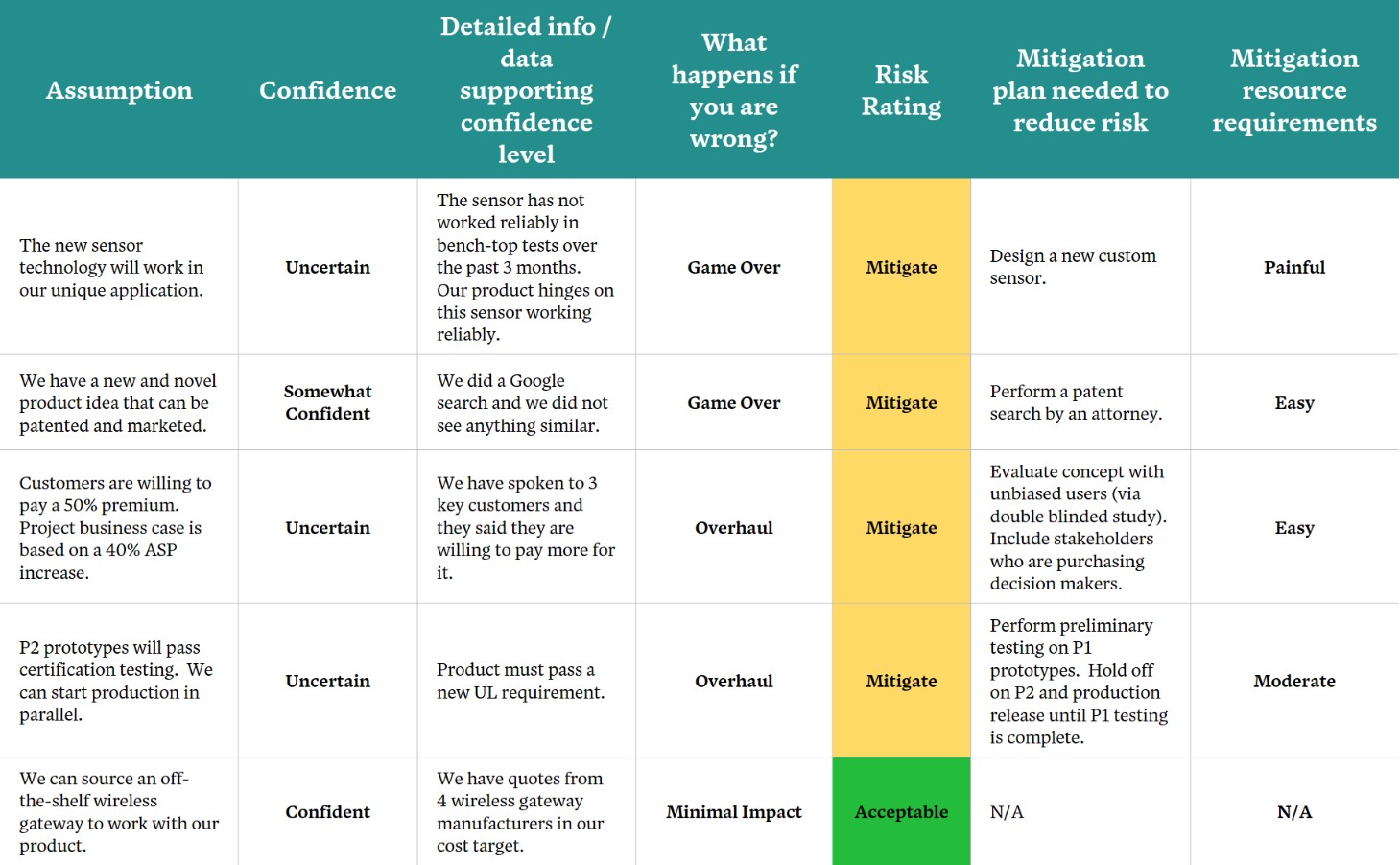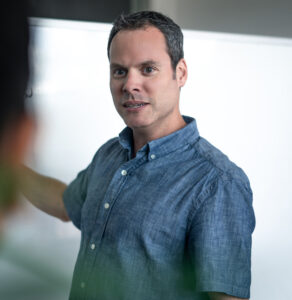
Article
How to Mitigate the Risks of Speeding Up Your Product’s Time to Market
Skipping a concept or strategy phase in product development means getting to market faster. But is this strategy worth the risk? Here’s what to consider.
When you’re pressured to bring a new product to market quickly, it can be tempting to skip steps in the development process. But what if skipping these steps leads you to end up with nothing? What if by going too fast and incurring too much risk, you allow a competitor to beat you to the market?
If you want to fast-track your product, you’d better understand the risks of your decisions. There’s a process for a reason.
Here’s a deeper look at the areas and phases clients often want to trim or cut out altogether — and how to mitigate your risk if you decide to veer from tried and true best practices.
Wondering how your management and project teams can fast-track projects with confidence? Download the Project Risk Assessment Tool to evaluate project risks and add certainty to your product development project.
The Strategy Phase: Not All Fluff and Absolutely Necessary
A well-designed product development process begins with strategy, moves to concept, and culminates with development.
The strategy phase sounds like a boondoggle, but it’s the crucial first step toward getting to a solid final result. This is where we develop a deep understanding of the product requirements, assess the size and scope of the project, conduct market and user research, and create a flexible, workable plan. This includes evaluating shortcomings of existing product lines and developing a market analysis to lay out how your product differentiates you from your competitors.
Clients with limited budgets or those up against hard-and-fast deadlines often ask if we can truncate or eliminate the strategy phase. And look, we get it. Product development is expensive and it takes a lot of time. If you’re a start-up with limited capital, you feel like you don’t have a single moment to waste until your product launches. And you certainly are in a race to launch product and start generating revenue.
On the other hand, if you’re a well-established company who has brought other products to market, you may genuinely believe you’ve done the research necessary to define the product and market requirements. You just want a firm to design the dang thing and stop overthinking it.
The Bathtub of Value and the Strategy Phase
Here’s the rub. As John Bergman said, “There is never enough time [or money] to do it right, but there is always enough time [and funding] to do it over.”
For example, by investing $10,000 and a few weeks into research during the strategy phase, you could save yourself well over $100,000 in wasted resources and months of time down the road. This is in line with the “bathtub of value” principle, which shows how ROI increases when resources are invested throughout the development process.
The surprising truth is that the strategy and concept phases yield more ROI than the development phase.
Lack of Strategy Can Lead to a Market Flop
We once worked with a client who essentially told us, “Here’s the product idea. Go design it.” We asked if we could talk to end-users directly and see the environment the product would live in. Their answer was a flat no. They wanted to be in stealth mode and felt they knew enough about the user and environment to relay any information to us. We worked on the project for upwards of six months and reviewed concepts with the client along the way. We kept asking for access to end-users or a customer site visit to better understand the environment. Requests denied.
When the client finally shared a fully functional prototype with their customers, the solution didn’t meet the end-users’ needs at all. It couldn’t be installed in the space available as it couldn’t integrate with other equipment. Sadly, it was a total flop and the project was canned.
Could we have avoided this worst-case scenario? Absolutely. All we needed was a site visit and a 30-minute conversation with the right people. This product never made it to market, and it’s because we couldn’t do the necessary strategy work.
If you decide to shortchange the strategy phase, do so with your eyes wide open and with an understanding of the risks involved. Also, don’t be surprised if we decline to take on the project. We don’t need to learn this lesson twice.
The Concept Phase: Marry Strategy with Innovation
During the concept phase, we evaluate multiple ways of solving the same problem. This is where we brainstorm and visualize creative options using collaborative techniques and processes. We sketch out design concepts, develop crude renderings, generate 3D CAD models and prototypes, and invite your feedback all along the way.
This phase is enjoyable, but it’s not all fun and games. It takes time and diligence to design, test, and iterate over and over again. We leverage what we learn from each prototype round before developing the next to make informed decisions. Eventually, we narrow our ideas down to a few concept finalists. From there, we recommend a direction to pursue into development and production readiness.
Clients who are eager to get to market quickly sometimes urge us to skip parts of the concept phase. They might take a look at the results of an early prototype and think, voila! All done. Let’s move forward.
Not so fast. We can’t be sure a concept meets the strategic goals of your project until we carefully evaluate it, test it, and solicit feedback. Do the end users like it? Does the prototype work the way it should? Does it fit within existing workflows or integrate seamlessly with other tools? Will it stand up to product certification and safety testing?
Embrace the beauty, creativity, and collaboration of the concept phase. Your end result will be better if you don’t try to shorten this important part of the journey.
Still Want to Head Straight to the Development Phase? Here’s How to Assess and Mitigate Your Risk
At the end of the day, only you can decide how much time and money you are able or willing to invest in the product development process. If you aren’t convinced you need to enter fully into the strategy and concept phases, here’s how to understand and mitigate the risk involved while skipping all or part of these steps.
If you’re fast-tracking to the end based on certain assumptions, how sure are you that your assumptions are correct? Take time to identify your assumptions, assess your confidence level in each one, and evaluate how severe the consequences will be if you are wrong.
For example, you might be heading into the project assuming that one prototype will be sufficient before you start ramping for production. Or, you may be banking on the fact that you will sail through product certification and safety testing. Perhaps you’re quite positive you’ve done all the necessary stakeholder and market research. Maybe you’re sure there is nothing else like this product on the market and consumers will line up to buy it.
Once you’ve listed all your assumptions, evaluate each one in terms of how certain you are that it’s true. How significant is the impact if you’re wrong? Would getting it wrong kill the project? Would it cause a major redesign or scrap production tooling? How much time or money will it cost to fix it?
Next, evaluate what activities can increase your confidence rating. How can you transform your assumption into a more solid projection? Do you need additional research, another prototype round, or more testing?
Take a look at this Risk Assessment Matrix and consider creating one like it. Use it to evaluate your project assumptions and create smart mitigation plans.

Put the Future of Your Product Into Capable Hands
If you want to see the benefits of quickly bringing a stellar product to market (and of course you do), be smart about how you approach the entire development process. If at all possible, don’t skip to the end. Instead, embrace what each phase brings to the process.
And to further increase your chances of success, engage a product design firm made up of talented people who aren’t content to simply take orders from you. Rely on your partners in design to help you think through the gaps you’ve missed, challenge your assumptions, and collaborate with you toward a superior end result. Put your product into capable hands and trust the process. One day soon you’ll launch an exciting product that will bring your company the ROI you’re after.
Want to learn more? We’d love to hear from you.





